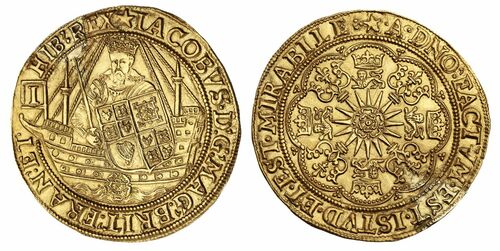
Auction: 23051 - English Milled and Hammered Coins and Artefacts
Lot: 1113
James I (1603-1625), Second Coinage, 'Ship Noble' or Spur Ryal, 1611-1612, Tower, (m.m.) IACOBVS • D .' G .' MAG .' BRIT .' FRAN .' ET • | H[IB .' R]EX, King holding sword and Royal shield, standing three-quarters facing in Galleon, double-rose set atop lower of two gun decks, ropes 3/3, I on standard, plain masts either side of King, choppy waters lap below, rev. (m.m.) • A • DNO .' FACTVM • EST • ISTVD • ET • EST • MIRABILE : (the colon over the key), rose upon radiant sun, alternating crowned Leopards and floriate cross terminals in angles, small trefoils in spandrels, 6.60g, 6h, m.m. mullet [over key] (HCN 205 same dies; Montagu III, 136 = Murdoch I, 686 = Lingford II, 893 same dies; Rashleigh [1909], 858 = BM 1935.0401.6994 same dies; Clarendon II, 1120 this coin; Schneider II, 12-13, same obverse die; North 2080; Spink 2614), a repair between 10 and 11 o’clock but still with daylight crack, otherwise a remarkably bold survivor with many redeeming qualities both in uniformity of strike and originality of overall surfaces, a really bold very fine / near extremely fine, and excessively rare thus
Provenance
Heritage, ANA Signature Sale 3109, 17-19 August 2023, lot 31167
Baumhauer, Part III, Sincona ‘British’ Auction 79, 24 October 2022, lot 1095
SJA 6, 8 June 2007, lot 115 - "the flan slightly cracked and discoloured at 11 o’clock, otherwise nearly extremely fine, very rare" [Baumhauer]
[Bohr] ‘Clarendon’, Part II, Bonhams, 17 October 2006, lot 1120 [image and weight confused with lot 1119] [Knightsbridge]
Patrick Finn, FPL 7, Spring 1996, no. 15* - striking crack along sword from King’s shoulder to the edge, otherwise EF and very rare - £4,500
“An old Finn client in Manchester would provide Patrick with Hammered gold coins for his early lists as he had not been confident to handle these during his time at Spink”
There are only three specimens of this pyx mark known for this celebrated albeit rather incongruous Jacobean specie. The first is the remarkable Alderman Horace Hird specimen graded NGC MS64 STAR prior to its handling by Spink, which ultimately ensured that it sold for a breathtaking £302,000 (~ $428,000) in these rooms in September 2021 and for now remains safely stored in the Tyrant Collection. The other passed through the Evelyn Rashleigh sale in 1909, to T B Clarke-Thornhill, whose generous bequest to the British Museum in 1935 ensured missing die pairings of the rarest English coins would be saved for the nation. Amongst a legendary Queen Anne Vigo Five-Guineas, and varieties of the fabled Henry VII Gold Sovereign issues, the other known example of a mullet-signed Jacobean Ship Noble entered the care of the trustees of the National Collection. Consequently the present example, its faults acknowledged, remains the only example at the present time available to private collectors.
This obverse die is one of the most remarkable to be employed in the long and illustrious history of the English coinage. Whilst overpunched pyx marks are frequent during the reigns of the Stuart Kings, typically the refurbished die is re-marked only once, and in very rare instances twice. However in this particular case, the die evidently sunk during the pyx period of the Key (1609-1610), is re-employed not just for the Mullet (1611-1612) issue as seen here, but also for the subsequent Tower, Trefoil and Cinquefoil privy marks, in effect four times, as testified by the Schneider collection. The British Museum also possesses a further unique coin, exhibiting either the tun or possibly book pyx symbol, again from the same obverse die.
Obvious conclusions can be drawn about the serviceable life of the die, which must have been at least four years and perhaps as long as seven. For economic historians and numismatists alike this is a clear indication of the extremely short supply of Ship Nobles struck for circulation between 1611 and 1615, reflective of the shortage of bullion during this period, and tantalising evidence for the revaluation of the gold specie in November 1611, commoditising this coin at 16 Shillings and Sixpence.
Subject to 20% VAT on Buyer’s Premium. For more information please view Terms and Conditions for Buyers.
Sold for
£9,000
Starting price
£15000




